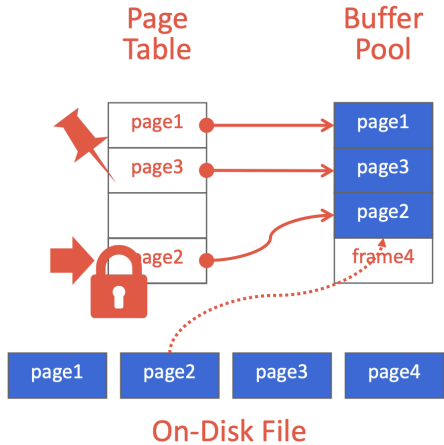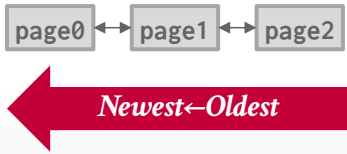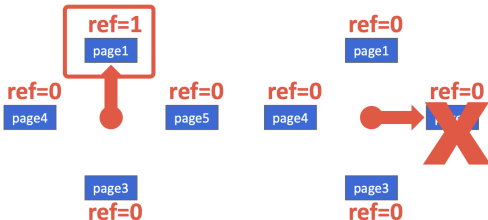Lecture 04: Memory & Disk Management¶
约 558 个字 4 张图片 预计阅读时间 3 分钟 共被读过 3 次
15-445/645 Database Systems (Spring 2025)
Carnegie Mellon University
Prof. Jignesh Patel
📌 Key Concepts¶
1. Disk-Oriented DBMS¶
- Primary Storage: Persistent storage (HDD/SSD).
- Buffer Pool Manager: Moves data between disk and memory.
- Illusion: Database appears fully in memory, even if larger than available RAM.
Optimization Goals:
1. Spatial Control: Keep related pages physically close on disk (improves prefetching).
2. Temporal Control: Minimize disk I/O stalls by managing when pages are loaded/evicted.
2. Buffer Pool Organization¶
- Structure: Array of fixed-size frames (each holds a page copy).
- Write-Back Cache: Dirty pages are buffered, not immediately written to disk.
- Page Table: In-memory hash table mapping page IDs → buffer pool frames.
Meta-Data per Page:
- Dirty Flag: Indicates if modified (needs write-back).
- Pin/Reference Counter: Tracks active accesses (pinned pages cannot be evicted).
- Access Tracking: Used for replacement policies (e.g., LRU timestamps).
3. Locks vs. Latches¶
| Locks 🔒 | Latches 🔩 |
|---|---|
| Protect logical DB content (e.g., tuples). | Protect internal data structures (e.g., hash tables). |
| Held for transaction duration. | Held for operation duration. |
| Support rollbacks. | No rollback needed. |
| Example: Row-level locks. | Example: Mutexes for page table access. |
4. Page Table vs. Page Directory¶
- Page Directory: On-disk mapping of page IDs → physical locations.
- Page Table: In-memory mapping of page IDs → buffer pool frames.
Example:
- Page Directory entry: Page#5 → Disk Block 1023.
- Page Table entry: Page#5 → Frame#7 (Dirty: True, Pin Count: 2).
5. Why Not Use OS mmap? 🚨¶
Problems:
1. Transaction Safety: OS may flush dirty pages prematurely.
2. I/O Stalls: Threads stall on page faults (DBMS can’t predict which pages are in memory).
3. Error Handling: SIGBUS errors on invalid page access.
4. Performance: TLB shootdowns and OS contention.
DBMS Advantages:
- Control over flushing order, prefetching, replacement policies, and thread scheduling.
OS Workarounds (e.g., madvise, mlock, msync) are as complex as manual management.
🔄 Buffer Replacement Policies¶
Goals:¶
- Correctness: Avoid evicting pinned/dirty pages.
- Accuracy: Predict future access patterns.
- Speed: Low overhead.
- Low Meta-Data: Minimal per-page storage.
1. Least Recently Used (LRU)¶
- Mechanism: Track last access timestamp; evict oldest page.
- Implementation: Sorted list or priority queue.
- Example:
- Pages:
[A (ts=10), B (ts=5), C (ts=15)]→ Evict B.
Weakness:
- Sequential Flooding: Scans pollute the buffer pool (e.g., SELECT * FROM table evicts useful pages).
2. CLOCK (Approximate LRU)¶
- Mechanism:
- Each page has a reference bit (1 if accessed recently).
- Clock hand sweeps frames; evicts pages with reference bit = 0.
- Example:
- Pages:
[A (ref=1), B (ref=0), C (ref=1)]→ Evict B.
3. LRU-K¶
- Mechanism: Track last K accesses to predict future use.
- Example:
K=2: Page A accessed at times[t=5, t=10]→ Interval = 5.- Prefer evicting pages with longer intervals (less frequently accessed).
Tradeoff: Higher meta-data overhead.
🧩 Handling Dirty Pages¶
- Fast Path: Non-dirty pages are simply dropped.
- Slow Path: Dirty pages must be written to disk before eviction.
Optimization:
- Background Writing: Periodically flush dirty pages to reduce eviction latency.
🚀 Buffer Pool Optimizations¶
1. Multiple Buffer Pools¶
- Purpose: Reduce contention (e.g., separate pools for indexes and tables).
- Mapping: Use hashing or object IDs to assign pages to pools.
2. Pre-Fetching¶
- Mechanism: Load pages needed for future operations (e.g., sequential scans).
- Example:
- During a
B+Treeindex scan, prefetch sibling leaf pages.
3. Scan Sharing¶
- Mechanism: Multiple queries reuse a single scan cursor.
- Example:
- Query 1 scans
Table X; Query 2 attaches to the same scan.
⚠️ Key Takeaways¶
- Avoid OS mmap: DBMS needs full control over memory management.
- Replacement Policies: Balance accuracy and overhead (CLOCK > LRU for large pools).
- Optimize I/O: Use Direct I/O, prefetching, and multiple pools.
📊 Final Thought: The OS is not your friend! 🛑



